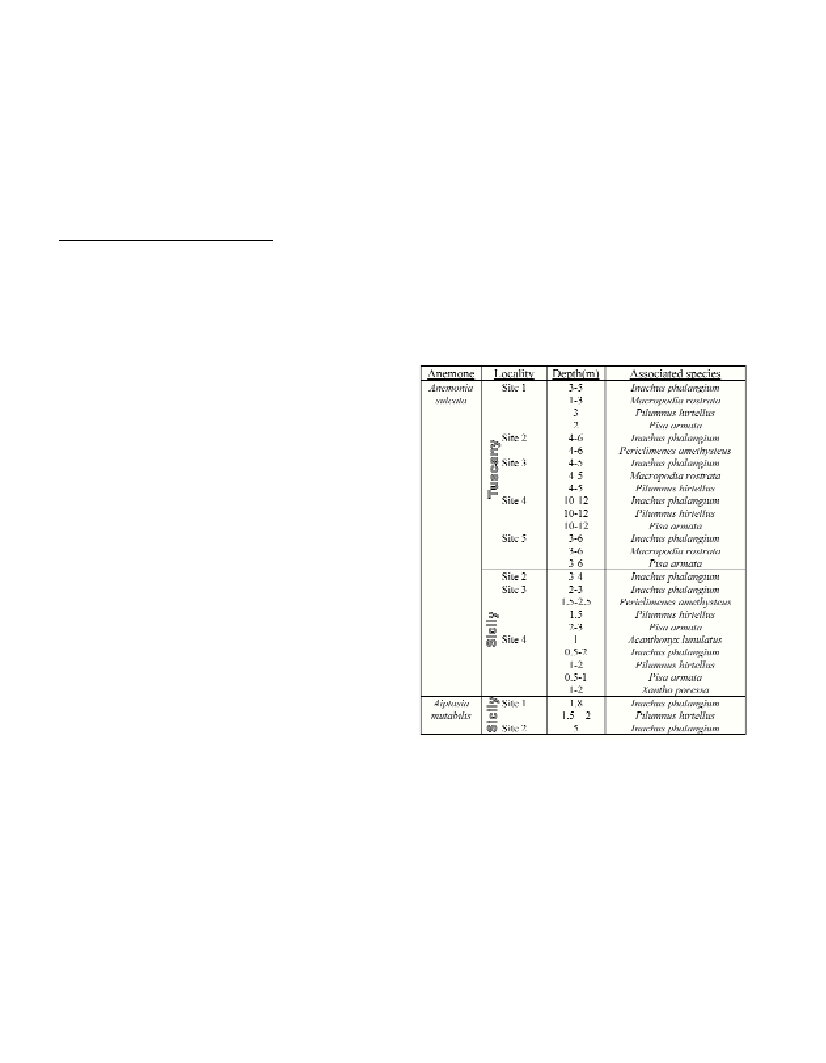NEW DATA ON THE ASSOCIATION BETWEEN SEA ANEMONES AND DECAPODS
ALONG THE ITALIAN SHORES: SYMBIONTS INSIDE, SYMBIONTS OUTSIDE?
Rocco Rorandelli
*
, Fabrizio Bartolini, Marina Gomei, Stefano Cannicci
Dipartimento di Biologia Animale e Genetica “Leo Pardi”, Universitŕ degli Studi Firenze, Italia
* rocco.rorandelli@unifi.it, fabriaran@yahoo.it, gomei@unifi.it, cannicci@dbag.unifi.it
Abstract
This work focuses on the association between decapods and some sea anemones. Previous studies mentioned fewer species of decapods
associated with anemones than found in our work. Our surveys brought to the surface a more multifaceted and complex reality, and a
discrete structure in their distribution and presence. Our goal is to concentrate on some of these species in order to learn more about the
type and modes of this association: can it be considered a real symbiosis?
Keywords: decapod, association, anemone
Rapp. Comm. int. Mer Médit., 37,2004
545
The Actiniaria are often commensals of other organisms, best
known are their relations with hermit crabs, which carry them on their
shells. The study is centred on the association between two sea
anemones, Anemonia sulcata, Pennant 1777 and Aiptasia mutabilis,
Gravenhorst 1831, and decapod crustaceans. Previous studies showed
that Inachus phalangium, I. dorsettensis, Hyas araneus, Macropodia
rostrata, Pisa armata and Periclimenes amethysteusmay be associat-
ed with A. sulcata, but only I. phalangiumwas known to be associat-
ed with A. mutabilis (4).
We collected data during several expeditions in coastal localities in
southern and central Italy, in particular, northwestern Sicily and cen-
tral and southern Tuscany. During the surveys each team of 2 divers
covered a transect of 20 x 20 m
2
each in a restricted range of depths
(0 to -10 meters), and for each encountered anemone the following
information was recorded: species identity and dimension, depth, sub-
stratum, orientation. Anemones were closely analysed with non-inva-
sive handling techniques in order to detect all the possible decapods
living in association with them. Species, size, gender, and number of
associates were recorded for a later analysis.
Our preliminary data, analysed by vigorous statistical methods,
show the presence of never-seen-before crabs that dwell among or
under anemone tentacles, in addition to a hierarchy in the incidence of
associated species, demonstrating that the one offered by sea
anemones is a multi-layer community with a real microhabitat struc-
ture, definitely more complex than previously thought (Table 1).
Future work will encompass two major issues: the ecology of the
microhabitat, with particular attention to the mechanisms that enable
them to share resources, to enable us to judge whether these decapods
live in sympatry, hence in competition with one another, or else how
they share their niche; and on the physiological and ethological bases
of the decapod relationship with anemones. This will enable us to
more specifically address the nature and the value of this mutualistic
association.
References
1-P. Castro – M. E. Huber, 1992. Marine Biology (ed), Mosby Year Book,
St. Louis.
2-S. R. Santos, D. J. Taylor, and M. A. Coffroth, 2001. Genetic
comparisons of freshly isolated versus cultured symbiotic dino?agellates:
implications for extrapolating to the intact symbiosis. J. Phycol.,37(5):
900 - 912.
3-T. C. LaJeunesse, 2001. Investigating the biodiversity, ecology, and
phylogeny of endosymbiotic dino?agellates in the genus Symbiodinium
using the ITS region: in search of a “species” level marker. J. Phycol.,
October, 37(5): 866 - 880.
4-Taylor DL., 1969. The nutritional relationship of Anemonia sulcata
(Pennant) and its dino?agellate symbiont. J Cell. Sci.,4(3): 751-62.
5-P.Wirtz, R.Diesel, 1983. The social structure of Inachus phalangium, a
spider crab associated with the sea anemone Anemonia sulcata. Z.
Tierpsychol, 62: 209-234.
Table.1. Decapods found in association with Anemonia sulcata and
Aiptasia mutabilis in our sampling sites.
Sites number correspond to the following: Western Sicily, “Capo Gallo –
Isola delle Femmine Marine Protected Area”: Addura: Site 1; Avamposto:
Site 2; Isola delle Femmine: Site 3; Barcarolo: Site 4. Central Tuscany:
Castiglioncello – Calafuria: Site 1; Affrichella Island: Site 2. Southern
Tuscany: Argentario: Site 3; Giglio Island: Site 4; Porto Santo Stefano –
Scarlino: Site 5.

